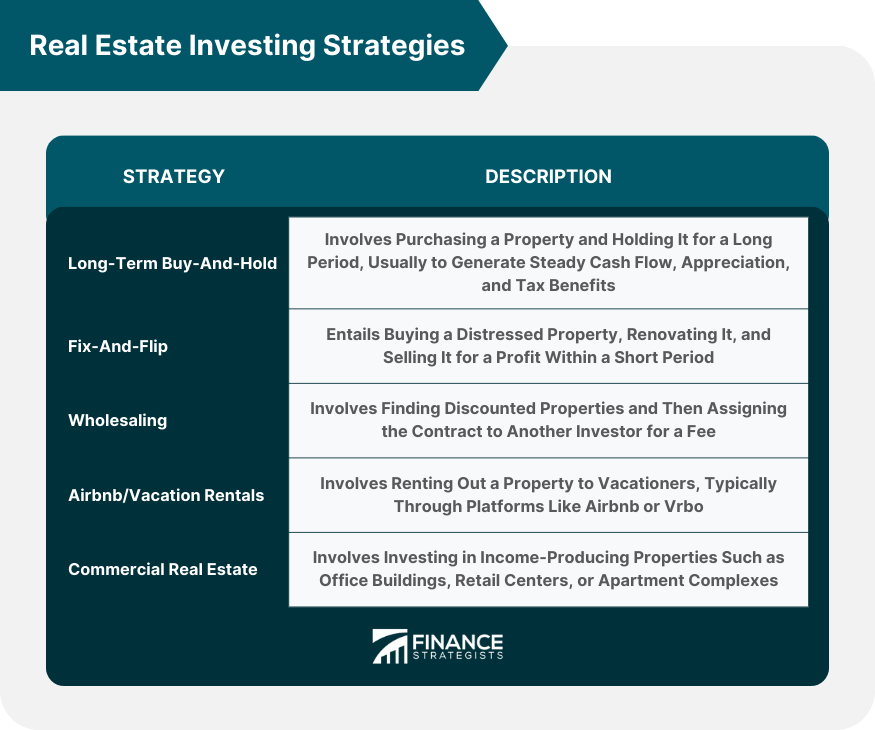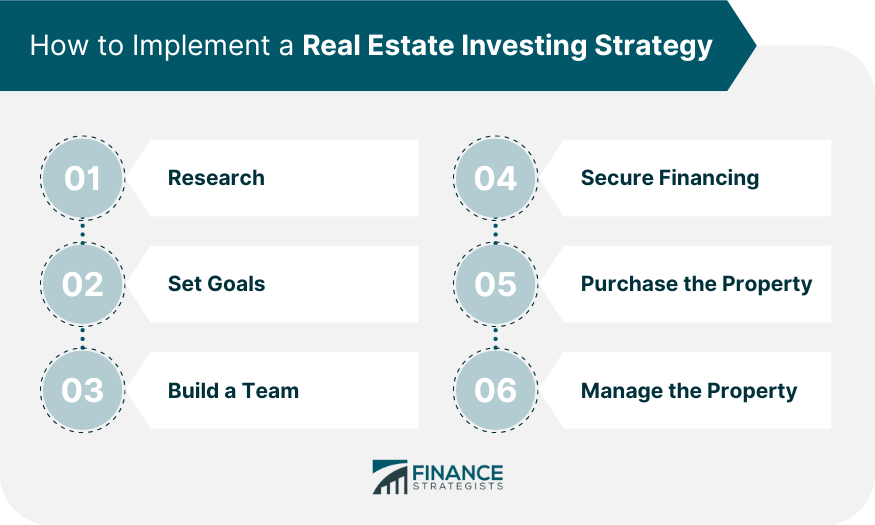Real estate investing strategies are the various methods and approaches investors use to generate profits through the acquisition, ownership, management, and sale of properties. These strategies can differ significantly based on factors such as time horizon, risk tolerance, and expected return on investment. Understanding and employing the right real estate investing strategy is crucial for investors to succeed in the property market. A well-defined strategy enables investors to make informed decisions, minimize risks, and maximize returns while aligning their investments with their financial goals and market conditions. The long-term buy-and-hold strategy involves purchasing a property and holding onto it for an extended period, typically renting it out to generate steady rental income. This strategy relies on the property's appreciation over time, which often results in significant capital gains when the property is eventually sold. The primary advantage of the buy-and-hold strategy is its potential for long-term wealth creation. As property values generally increase over time, investors can benefit from both ongoing rental income and capital appreciation. Additionally, this strategy allows investors to take advantage of various tax benefits, such as depreciation deductions and the potential for long-term capital gains tax rates. Fix-and-flip is a short-term real estate investing strategy where an investor acquires a property in need of repairs or renovations, makes the necessary improvements, and then sells the property quickly for a profit. The goal is to minimize the holding period and maximize the return on investment. This strategy can be lucrative for experienced investors with a keen eye for undervalued properties and strong project management skills. However, it is also riskier than other strategies, as it requires a significant upfront capital investment, and there is always the possibility of unexpected expenses or a downturn in the market affecting the resale value. Wholesaling is a real estate investing strategy where an investor acts as a middleman between a property seller and a potential buyer. The investor contracts the property at a discounted price, then assigns or sells the contract to another investor or end buyer at a higher price, earning a profit in the process. Wholesaling can be an attractive strategy for investors with limited capital, as it typically requires little to no money down. However, it is crucial to have a solid understanding of property values, negotiation skills, and a network of buyers to successfully wholesale properties. Additionally, this strategy generally offers lower profit margins compared to other strategies, such as fix-and-flip or long-term buy-and-hold. The Airbnb/vacation rental strategy involves renting out a property on a short-term basis to travelers, typically through platforms like Airbnb or VRBO. This strategy can generate higher rental income compared to traditional long-term rentals, as the nightly rates are often higher, and the property can be rented out year-round. Investing in Airbnb/vacation rentals requires careful consideration of factors such as location, property type, and local regulations. Additionally, this strategy can be more management-intensive, as it involves dealing with frequent guest turnover, cleaning, and maintenance. However, it can be highly profitable for those willing to invest the time and effort in managing their properties effectively. Commercial real estate investing involves the acquisition and management of properties designed for business purposes, such as office buildings, retail centers, or industrial facilities. This type of investing can offer substantial income potential, as commercial leases often have longer terms and higher rental rates compared to residential properties. Commercial real estate investing can be more complex than residential investing, as it requires a deeper understanding of market dynamics, property management, and leasing arrangements. It also typically demands a higher initial capital investment. However, the potential for stable, long-term income and significant capital appreciation can make commercial real estate an attractive option for experienced investors with sufficient resources. Market conditions play a crucial role in determining the success of a particular real estate investing strategy. Investors should carefully analyze current and projected economic trends, local property values, and rental demand to identify which strategies are best suited for the prevailing market conditions. In a rising market with strong demand for housing, strategies such as fix-and-flip or long-term buy-and-hold may yield higher returns. Conversely, in a softer market with lower property values and decreased demand, strategies like wholesaling or focusing on rental income may be more suitable. Location is a key factor in the success of any real estate investment. Investors must consider factors such as local job growth, population trends, infrastructure developments, and neighborhood amenities when selecting a property and an investment strategy. Different locations may lend themselves better to specific strategies. For example, vacation rentals might be more lucrative in popular tourist destinations, while commercial real estate investments may perform better in areas with strong business activity. The amount of capital an investor has available will significantly impact their choice of real estate investing strategy. Some strategies, such as fix-and-flip or commercial real estate investing, require substantial upfront capital for property acquisition and improvement. In contrast, strategies like wholesaling or Airbnb/vacation rentals may require less initial investment. Investors should carefully assess their financial resources and choose a strategy that aligns with their budget and long-term financial goals. Different real estate investing strategies come with varying levels of risk. Investors must consider their personal risk tolerance when choosing an investment strategy. For example, fix-and-flip investments can offer high returns but also come with the risk of unexpected expenses or market downturns, while long-term buy-and-hold investments tend to be less risky but may have lower returns in the short term. An investor's personal goals and investment objectives should also be taken into account when choosing a real estate investing strategy. Some investors may prioritize passive income and long-term wealth creation, while others may focus on short-term capital gains or diversifying their investment portfolio. By aligning their strategy with their personal goals, investors can maximize their chances of success in the real estate market. Thorough research is the foundation of a successful real estate investment strategy. Investors should gather information on market conditions, property values, rental rates, and local regulations to identify potential opportunities and risks. Online resources, local real estate agents, and networking with other investors can be valuable sources of information. Setting clear, achievable goals is essential for staying focused and motivated throughout the real estate investing process. Investors should establish both short-term and long-term objectives, such as desired rental income, property appreciation, or the number of properties to acquire within a specific timeframe. Real estate investing often requires collaboration with various professionals, such as real estate agents, attorneys, property managers, and contractors. Building a reliable team can help investors navigate the complexities of the real estate market and ensure a smoother investing experience. Securing financing is a critical step in implementing a real estate investing strategy. Investors should explore various financing options, such as conventional mortgages, hard money loans, or private lending, and select the best option based on their strategy and financial situation. Once financing is secured, investors can proceed with acquiring the property. This process involves negotiating with the seller, conducting due diligence, and finalizing the purchase through closing. Effective property management is crucial for maximizing returns on real estate investments. Investors should develop a plan for maintaining the property, managing tenants, and addressing any issues that arise. Depending on their strategy and personal preferences, investors may choose to manage the property themselves or hire a professional property management company to handle these tasks. In summary, there are several real estate investing strategies available to investors, including long-term buy-and-hold, fix-and-flip, wholesaling, Airbnb/vacation rentals, and commercial real estate. Each strategy comes with its own set of advantages, challenges, and risk factors. By carefully considering market conditions, location, capital, risk tolerance, and personal goals, investors can select the best strategy to achieve their desired outcomes. Real estate investing can be a rewarding and profitable endeavor for those who take the time to research, plan, and execute a well-defined strategy. It is essential to continually monitor and adjust the chosen strategy based on changing market conditions and personal circumstances. By staying informed, flexible, and focused on their goals, investors can build a successful real estate portfolio and enjoy the financial benefits that come with it.What Are Real Estate Investing Strategies?
Types of Real Estate Investing Strategies
Long-Term Buy-And-Hold
Fix-And-Flip
Wholesaling
Airbnb/Vacation Rentals
Commercial Real Estate

Factors to Consider in Choosing a Real Estate Investing Strategy
Market Conditions
Location
Capital
Risk Tolerance
Personal Goals
How to Implement a Real Estate Investing Strategy
Research
Set Goals
Build a Team
Secure Financing
Purchase the Property
Manage the Property

Conclusion
Real Estate Investing Strategies FAQs
Long-term buy-and-hold, fix-and-flip, wholesaling, Airbnb/vacation rentals, and commercial real estate are some common types.
Consider market conditions, location, capital, risk tolerance, and personal goals when choosing a strategy that suits you.
Real estate investing strategies are plans and techniques used by investors to maximize their return on investment in real estate. These strategies are important because they help investors minimize risks, identify profitable opportunities, and make informed investment decisions.
Research, set goals, build a team, finance, purchase property, and manage it are the key steps to implementing a real estate investing strategy.
Real estate investing strategies for generating income include rental property investment, REIT investment, property flipping investment, and real estate partnership investment.
True Tamplin is a published author, public speaker, CEO of UpDigital, and founder of Finance Strategists.
True is a Certified Educator in Personal Finance (CEPF®), author of The Handy Financial Ratios Guide, a member of the Society for Advancing Business Editing and Writing, contributes to his financial education site, Finance Strategists, and has spoken to various financial communities such as the CFA Institute, as well as university students like his Alma mater, Biola University, where he received a bachelor of science in business and data analytics.
To learn more about True, visit his personal website or view his author profiles on Amazon, Nasdaq and Forbes.











